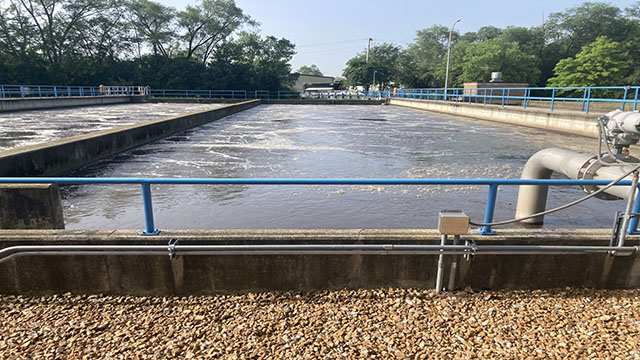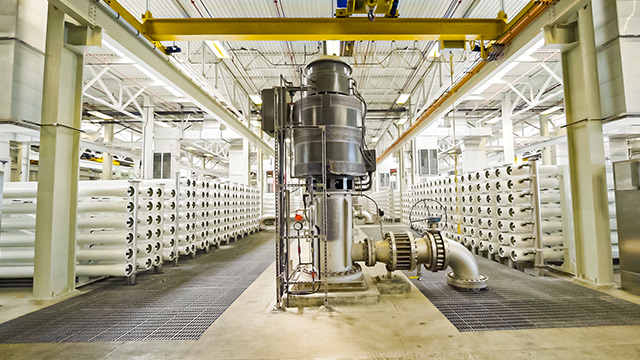Utilities entrusted to supply sustainable, clean drinking water have their hands full eliminating contaminants of emerging concern and ensuring that reactions in the distribution system do not produce separate contamination issues.
Simple physical and chemical treatment methods that include sedimentation, filtration and disinfection have long been the standard in drinking water purification. As the Black & Veatch’s 2020 Strategic Directions: Water Report survey shows, dealing with certain contaminants — some at the behest of evolving regulations — are proving increasingly challenging.
Man-made chemicals — notably decades-old per- and polyfluoroalkyl substances (PFAS) known as “forever chemicals” because they don’t easily biodegrade — have joined nitrates/nitrites and lead as the water contaminants of greatest concern to drinking water stakeholders surveyed. The results represent a combination of stakeholder concern for removing these contaminants at drinking water treatment facilities as well as the health and environmental concerns from contaminants found in potable water or water sources. Almost 50 percent of stakeholders cited PFAS as a chief contaminant of concern, followed by nitrate and nitrite at 34 percent and lead at 26 percent, with other contaminants all below 20 percent.
2020 Strategic Directions: Water Report
With its survey of nearly 300 water industry stakeholders as its backbone, Black & Veatch’s 2020 Strategic Directions: Water Report comprehensively analyzes the sector’s complex landscape of challenges and opportunities. The leveraging of data in driving decision-making and optimizing efficiencies in water and wastewater systems is widening even as infrastructure continues to age, climate change strains assets, and the COVID-19 pandemic’s financial havoc pressures the bottom lines of many utilities through lost revenues. We look at all of that and more.
PFAS: One Big Family Tree of Chemicals
A large family of more than 5,000 man-made chemicals, PFAS have been used for decades in industrial and consumer products. They are ubiquitous, found in nearly every home and business – in items such as non-stick cookware, firefighting foams, grease-resistant takeout food packaging, waterproof outerwear, stain-resistant carpeting and personal care products.
Two specific PFAS chemicals — perfluorooctanoic acid (PFOA) and perfluorooctane sulfonate (PFOS) — are of particular concern. Use of those chemicals was voluntarily discontinued nearly two decades ago, but true to their moniker as “forever chemicals” they persist and are still found in surface and groundwater.
Federal and state regulators took steps in 2019 to tighten drinking water regulation of PFAS, with the U.S. Environmental Protection Agency (EPA) expected to amplify oversight this year beyond the EPA’s current non-enforceable health advisory (HA) level of 70 parts per trillion (ppt) for the sum of PFOA and PFOS. Some two dozen states have policies that include HAs about PFAS in drinking water ranging from 10 ppt to 40 ppt for individual PFOA or PFOS compounds or a sum of PFAS compounds as low as 20 ppt (i.e., Vermont and Massachusetts). It seems likely that some of these states will move forward with tougher regulations on those substances in 2020 or shortly thereafter, which is what happened with New Jersey in June 2020, when it established maximum contaminant levels (MCLs) of 13 ppt for PFOS and 14 ppt for PFOA, which are some of the lowest in the country.
PFAS Detection, Monitoring Expected to Climb
While PFAS has drawn increasing scrutiny, it is not surprising to see that nitrite/nitrate, metals and biologicals are the most commonly monitored and detected groups of contaminants by drinking water facilities, since these groups include regulated contaminants like lead, copper, iron, heavy metals, coliforms, viruses and nitrification byproducts of nitrite and nitrate.
Nearly half of respondents indicated they monitor and have detected PFAS, which was the highest value for contaminants that are not currently regulated. One-third of respondents said they are monitoring for PFAS but haven’t detected any. These monitoring and detection values are expected to increase as PFAS were included in the EPA’s unregulated contaminant monitoring rule (UCMR) 5.

Regulatory Questions Make PFAS Efforts Murky
When it comes to removing PFAS from water, regulatory uncertainty abounds. Without clarity on future regulatory limits, it is difficult for utilities to confidently set treatment goals or identify the appropriate treatment technology. Sixty percent of respondents pointed to that lack of clarity as their biggest limiting factor for their utility’s quest to deal with PFAS in water supplies. Lacking health science guidance and the cost and recovery of water treatment options are a distant second and third, each garnering less than 20 percent.
Ultimately, drinking water utilities are faced with producing a finished product that meets regulatory standards, while also responsibly disposing of waste streams. It’s clear that emergent PFAS chemicals in water sources are posing unique challenges for water utilities as they often necessitate advanced treatment technologies and hinder traditional approaches to handling waste streams. Scientists and regulators remain in an early stage of discerning the effects of PFAS on human health and developing technologies to remove them from water. But as the science progresses, PFAS regulatory activities are expected to accelerate increasing pressure on utilities to remove them.

Confidence Plentiful that Contaminants will be Removed
As for the confidence level of their utility’s ability to meet current and still-evolving contaminant levels established by state and federal agencies, responses were varied. One-third voiced extreme confidence in their adherence to dynamic standards for various contaminants, slightly more than those who considered themselves very or moderately confident. No respondent reported lacking confidence in their utility’s compliance.
The unspoken caveat behind those responses could come down to money, as is often the case for a utility. Compliance with certain standards could be technologically possible, but at what cost?
Traditional drinking water treatment plants are very effective at removing biological and physical contaminants such as sediment and organic materials from the influent water, but these facilities are less effective at removing certain chemicals. For that reason, respondents indicated similar concern over the presence of chemicals in their water source as in the treated water.
Drinking water stakeholders cited more concern over biological contaminants in the treated water than in the source water, which could be an indication of the recognition that biological contaminants like coliforms and viruses are regularly present in many upstream water sources and confidence in treatment systems abilities to remove then under normal operation. The level of concern for biological contaminants downstream in a drinking water system encompasses both the recognition of the possibilities of treatment failures and the opportunity for regrowth in the distribution system.
If sudden changes are observed in the loading rate of physical contaminants, like sediment and plastics, it can cause upsets in utility operations, resulting in excess solids production or more frequent backwashing of treatment processes to meet treatment goals. This explains the higher concern of physical contaminants in the source water rather than the treated water.
Lead Remains a Priority
With nearly 26% of drinking water respondents listing lead as a contaminant of concern, the third highest result (Figure 29), it is clear that it remains a priority for drinking water providers.
In 2019, the EPA proposed revisions to the Lead and Copper Rule that would increase monitoring requirements and create a lead trigger level that is lower than the current action level based on the presence of lead in drinking water at the tap. These changes primarily impact systems that have remaining distribution piping and components containing lead, such as lead service lines, lead solder and brass fixtures.
Removing lead service lines is mainly a challenge in the Upper Midwest and East Coast, where housing and infrastructure tends to be older than the rest of the nation. Removing lead service lines across the United States could cost more than $30 billion, and many of the service lines cross onto private property and are only partially owned by the drinking water utility.
When asked whether there were unknown pipe materials in a drinking water utility’s water distribution system, more than half encouragingly responded “no, none at all”. The high level of “no” responses could be due to greater asset diligence following lead release events in Washington, D.C., in 2004 and in Flint, Michigan, in 2015 and 2016. Those adverse events could have forced water utility managers to identify, with more specificity than ever before, what materials were used for pipes, valves and meters in their distribution systems.
Still, more than 40 percent of respondents answered some variation of “yes” to this question, possibly indicating that detailed asset inventories are under way or will be conducted when required by regulations.
Overall, the contaminants our drinking water facilities are tasked to remove is an everchanging list with ongoing adjustments to regulated levels. These facilities are designed with multiple levels of treatment using a combination of chemical, physical and sometimes biological processes to produce finished water that meets regulatory standards.
The challenge facing regulators and utilities, especially when considering PFAS, is agreeing to a required target treatment level that is both appropriate and achievable. Looking at the survey results in Black & Veatch’s 2020 Strategic Directions: Water Report, the overall picture that emerges is of an industry confident in its ability to provide high quality drinking water meeting current and future water quality target.
About the Authors
Nick Burns is the director of water treatment technologies at Black & Veatch. He has 19 years of experience with advanced water and reuse treatment technologies, and has worked in Australia and the Mideast, with project experience throughout the United States. He leads a team of drinking water process engineers solving treatment issues across North America.
Dustin Mobley is the drinking water PFAS leader at Black & Veatch. He has more than a decade of water process experience in the evaluation and design of water and wastewater treatment processes for municipal water treatment clients. His responsibilities have included engineering studies, conceptual design, front-end engineering design, detailed design, and procurement of water and wastewater equipment. Most recently, he has been involved in pilot testing and full-scale design of activated carbon and ion exchange technologies for the removal of PFAS from drinking water.
Christopher Tadanier is the West Region water process leader within the Water Technology Group at Black & Veatch. He specializes in source water quality evaluation, water treatment process selection and design, and environmental chemistry. He has performed dozens of water quality and treatability evaluations related to a variety of drinking water supply and treatment projects.
Emily Tummons is a drinking water process engineer and lead and copper corrosion control leader. She has designed and conducted water quality and corrosion studies for potable water treatment systems involving desktop, bench-scale and pipe-loop evaluations to optimize corrosion control in the distribution system. She also has been involved in process optimization studies and regulatory reviews for municipal drinking water treatment facilities.









